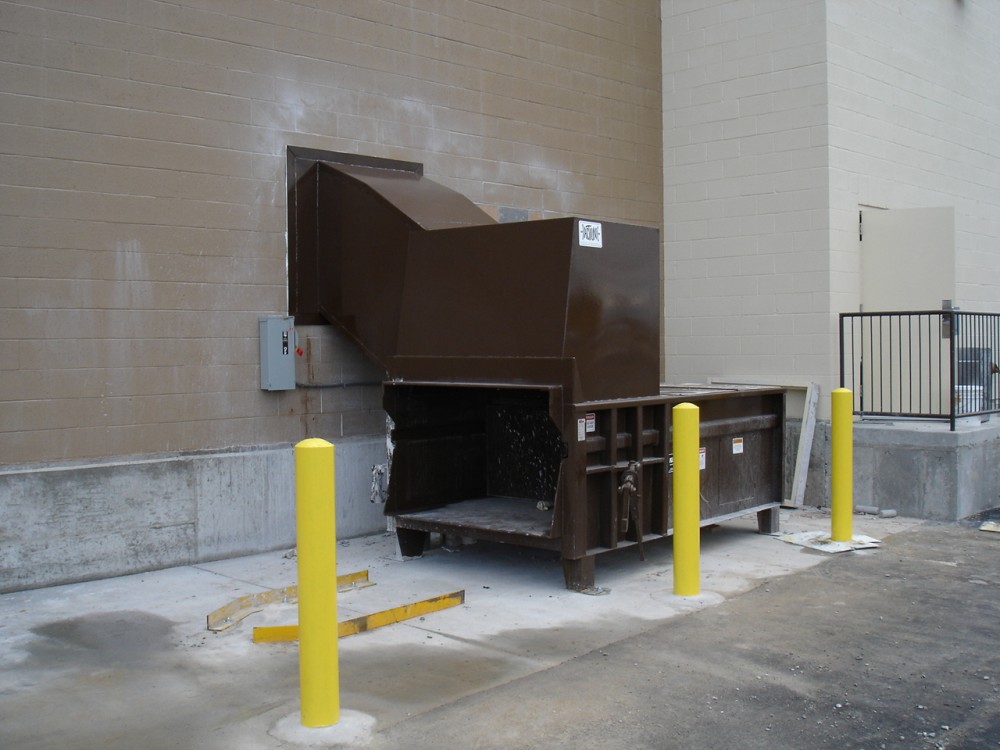Action Compaction Services has been a leader in compactors installation, maintenance, and repairs for years. We are well conversant with industrial compactors for every need and every scope. We also understand that maintaining your equipment efficiently functional is vital for the overall flow of business operation and your waste management program. This is why our company offers the highest quality compactors for commercial, industrial use.
Whether you need compactors for baling, crushing, or extracting, we will help you get the task done right and reliably. This article is a comprehensive guide on industrial compactors and services linked thereto.
How an Industrial Compactor Works
Typically, all commercial, industrial compactors apply the same principle. The equipment is first filled with waste to the brim, and when the operator runs it, the trash is pushed to an attached smaller container. The ram does all the pushing, and it extends into the depth of the container, compressing the trash into a smaller volume.
When the attached container cannot hold any more of the compressed waste, the waste hauler is engaged to empty the container and haul away the compacted waste. The cycle runs on repeat.
The ROI of an industrial compactor is the reduction of costs associated with waste hauling, vermin, odor, operation waste, fire, and pilfering hazards.
Features to Look for When Buying an Industrial Compactor
Generally, there are two forms of industrial compactors; Self-Contained and Stationary compactors.
Self-Contained Compactors: This equipment is used for managing wet waste. Although the compactor is still attached to a contained, there is an extra sump system for the safe removal of the liquid waste. Once the whole unit is full, the compactor is loaded onto a truck, and the waste is hauled into a landfill.
Stationary Compactors :Applied to handle dry waste such as metal, wood, among other non-recyclable waste products. This equipment is fixed on the ground at one position, and once its full of compacted waste, the container is removed and the waste emptied into a hauler.
The configurations applied to fill your compactor with waste vary depending on the type of waste, the available space, and the volume of the waste. Some of the available compactor configurations include chute fed, ground fed, hoppers, walk-on-decks, doghouses, and loading docks.
Another feature you should pay attention to is the size of the attached container. The container makes a huge difference depending on the type of waste, the size of the compactor, the volume of waste, and the frequency of the hauler. The standard industrial compactors use 8, 6, 4, or 2-yard containers, but it’s also possible to use a 20-40-yard container for maximum efficiency.
Commercial Compactors, Industrial Balers, and Garbage Compactors
The first two pieces of equipment are almost similar and are both used for processing non-recyclable materials. Once the waste material is fed into the equipment, it is subjected to great pressure by a pneumatic or hydraulic press. Once processed, the volume of your waste will be greatly reduced, making it easily manageable and cheaper to haul.
For further cost reduction, you can choose to invest in an industrial compactor with an automatic loading system.
On the other hand, a garbage compactor is relatively smaller than balers with the same capacity. This equipment is available in a variety of sizes for both commercial and residential installations. These compactors are great in handling soft and hard waste alike, which makes them the perfect option for institutions such as hospitals, factories, hotels, and manufacturing facilities. Some commercial compactors offer features preventing leaks, odor, and rodents – such are best for handling food waste.
Types of Compactors
With numerous types of industrial compactors on the market, you have plenty of options to choose from. Below are some of the most common types of compactors.
Roll Off Self-Contained Industrial Compactors
They are more common in schools, the service and retail industry, apartment buildings, shopping malls, restaurants, supermarkets, and hotels. This equipment is capable of handling virtually any amount of waste. Besides that, it’s leakproof, making it a great option for businesses dealing with highly liquid waste. It’s a great choice for a hospital setting.
Stationary Compactors
These are applied for dry waste management and recycling processes. Stationary compactors are ideal for retail outlets, distribution centers, manufacturing plants, shopping malls, and printing presses. They are known to effectively handle large volumes of dry waste. This compactor can easily compress paper, cardboard, or any other similar dry waste, increasing the volume of the attached container by about 400%.
Pre-Crushers
More popular for handling bulky or large items. When it comes to managing boxes, crates, pallets, drums, furniture, and other appliances, pre-crushers are real star players. The compactor is capable of increasing the payload by about 800% in comparison to the standard compactor. They are best suited for warehouses, manufacturing plants, and similar places.
Transfer Station Compactors
This equipment is used for waste treatment and the combating of foul smell, among other unhealthy elements. With a transfer station compactor, you can finally get done with the insects, rodents, scavenger birds, and flies. It’s recommended for municipal and County solid waste collection facilities to help keep the surrounding environment healthy, clean, and odor-free.
The Brown Bagger
It comes in a variety of models, and it’s effective for various waste compacting needs. The equipment is ideal for ordinary waste generators such as colleges, schools, universities, apartments, marketplaces, airports, hospitals, among other swarming areas that are breading zones of regular trash.
Front Load Self Contained Compactors
The equipment is ideal for moderately low waste generators such as high-rise apartments, fast-food joints, senior-citizen communities, motels, and local markets. With the front load self-contained waste compactor, you will cut the hauling frequency by a whopping 75%.
What a Compactor Offers
Have you been spending your money, time, or any other resource trying to reevaluate your waste management system? If so, here are some of the benefits that come with investing in an industrial compactor:
A fat wallet – Waste compacting reduces the cost associated with hauling large volumes of waste. Besides the hauling fee, more can be saved in terms of time and fuel needed for transportation.
A green economy – By compacting recyclable waste material, we participate in the journey towards achieving a better and healthier environment, making Green living a reality. It will also help save some space in the landfills.
Odor-free environment – Compactors fitted with air sanitization units and anti-rodent technologies help with the elimination of odor related to leftovers. They will also prevent rodents and other scavenging creatures away and ultimately help in keeping the surrounding environs healthy and free from foul smell.
Convenience – Our compactors are easy to use, and they will demand minimum maintenance. This helps you streamline your trash management program. By just hitting a button, the nuisance garbage will be turned into smaller and easily manageable volumes.
Maximizing Your Compactor
We have already established that all compactors work the same way. The basic principle is that you add your waste into the compactor, which is then crushed and compressed into the container to minimize the volume. The compacted waste is hauled into the landfill.
However, it’s not always that simple, as things can get a little complicated below the surface. The type of waste being generated by your business will determine the operation space matters, safety hazards, and hauling schedules.
You can reduce these costs by investing in a heavy-duty industrial compactor. Noticeable and measurable changes will include increased space, reduced hauls, and improved safety. A high-quality industrial compactor will combat foul smell and improve the aesthetic of your facility.
What Type of Compactor Is Best for You?
For proper management of wet waste, a self-contained industrial compactor is recommended. These state-of-the-art compactors are highly spacious for easier management of large volumes of waste.
Stationary Industrial compactors, on the other hand, are ideal for managing dry waste such as wood, metal, and other non-recyclables. With this equipment installed in your facility, you can have all your waste material reduced to just a fraction of its original volume in a blink of an eye. And what’s more, there are solar-charged versions of the stationary compactor, helping you save more on energy costs.
Industrial Compactor Services and Maintenance
Action Compaction Services offers compactor and Baler services with the expertise and capability to support your equipment maintenance and emergency service requirements. If you happen to be generating large volumes of industrial waste, our compactor services are an affordable option.
Our team will do all the installations for you and help you design a solution that meets all your waste management and recycling needs. Your compactor services may include maintenance, rental, and lease-to-own programs.
All our services are tailored towards achieving our clients’ business needs while considering the type and volume of the waste in question. With many compactor options to pick from, it’s advisable to include unique features such as volume, loading areas, and service frequency.
Advantages of Using a Compactor
• Reduced hauling cost by lowing the pickup frequency
• Avoiding trash overflow
• Saving up some space in the waste disposal site
• Enclosing and protecting cardboards from freezing and getting wet
• A clean and aesthetic business environment for your employees and customers
• There are numerous compactor configurations for business-specific requirements
Final Thought
Action Compaction Services offers compactor services in all settings, including schools, commercial and retail establishments, apartment buildings, shopping malls, hotels, factories, warehouses, manufacturing plants, and more. Our maintenance team offers installation and upkeep services during the course of our contract of service.



